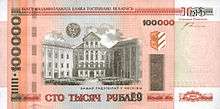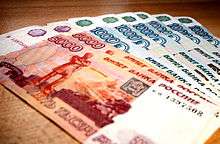Ruble
_front.jpg)


The ruble or rouble (/ˈruːbəl/; Russian: рубль; IPA: [rublʲ]) is or was a currency unit of a number of countries in Eastern Europe closely associated with the economy of Russia. Originally, the ruble was the currency unit of Imperial Russia, and it is currently the currency unit of Belarus, Russia and the partially recognised states of Abkhazia, South Ossetia, and Transnistria. The rubles of Belarus, Russia and Transnistria are distinct currencies. In the past, several other countries influenced by Russia and the Soviet Union had currency units that were also named rubles. One ruble is divided into 100 kopeks (Russian: копе́йка, tr. kopeyka; IPA: [kɐˈpʲejkə]).
Etymology
Origins
According to one version, the word "ruble" is derived from the Russian verb рубить, rubit, i.e., to cut, to chop, to hack, as ruble was considered as a cutout piece of a silver Gryvna.
In Russian:
Рубли были частями гривны или кусками серебра с зарубками, означавшими их вес. Каждая гривна разделялась на четыре части; название же рубль произошло от слова «рубить», потому что прут серебра в гривну весом разрубался на четыре части, которые и назывались рублями.
Rubles were parts of the grivna or pieces of silver with notches indicating their weight. Each grivna was divided into four parts; the name "ruble" came from the word "cut" because the silver rod weighing 1 grivna was split into four parts, which were called rubles.[1]
Another version of the word's origin is that it comes from the Russian noun рубец, rubets, i.e., the seam that is left around the coin after casting: silver was added to the cast in two steps. Therefore, the word ruble means "a cast with a seam".[2] A popular theory deriving word ruble from rupee is probably not correct.[3]
The ruble was the Russian equivalent of the mark, a measurement of weight for silver and gold used in medieval Western Europe. The weight of one ruble was equal to the weight of one grivna.
In Russian, a folk name for "ruble", tselkovyj (целко́вый, IPA: [tsɨlˈkovɨj], wholesome), is known, which is a shortening of the целковый рубль ("tselkovyj ruble"), i.e., a wholesome, uncut ruble. This name persists in the Mordvin word for ruble, целковой.
The word kopek, kopeck, copeck, or kopeyka (in Russian: копейка, kopeyka) is a diminutive form of the Russian kop'yo (копьё) — a spear. The first kopek coins, minted at Novgorod and Pskov from about 1534 onwards, show a horseman with a spear. From the 1540s onwards the horseman bears a crown, and doubtless the intention was to represent Ivan the Terrible, who was Grand Prince of all Russia until 1547, and Tsar thereafter. Subsequent mintings of the coin, starting in the 18th century, bear instead Saint George striking down a serpent.
Since the monetary reform of 1534, one Russian accounting ruble became equivalent to 100 silver Novgorod denga coins or smaller 200 Muscovite denga coins or even smaller 400 polushka coins. Exactly the former coin with a rider on it soon became colloquially known as kopek and was the higher coin until the beginning of the 18th century. Ruble coins as such did not exist till Peter the Great, when in 1704 he reformed the old monetary system and ordered mintage of a 28-gramme silver ruble coin equivalent to 100 new copper kopek coins. Apart from one ruble and one kopek coins other smaller and greater coins existed as well.
English spelling

Both the spellings "ruble" and "rouble" are used in English. The form "rouble" is preferred by the Oxford English Dictionary, but the earliest use recorded in English is the now completely obsolete "robble". The form "rouble" probably derives from the transliteration into French used among the Tsarist aristocracy. There are two main usage tendencies: one is for North American authors to use "ruble" and other English speakers to use "rouble", the other is for older sources to use "rouble" and more recent ones to use "ruble". Neither tendency is absolutely consistent.
The Russian plurals that may be seen on the actual currency are modified according to Russian grammar. Numbers 1, 21, 31 etc. (but not 11) are followed by nominative singular рубль, копейка. Numbers 2–4, 22–24, 32–34 etc. (but not 12-14) will be followed by genitive singular рубля, копейки. Numbers 5–20, 25–30, 35–40 etc. will be followed by genitive plural рублей, копеек.
Other languages
In several languages spoken in Russia and the former Soviet Union, the currency name has no etymological relation with ruble. Especially in Turkic languages or languages influenced by them, the ruble is often known (also officially) as som or sum (meaning pure), or manat (from Russian moneta, meaning coin).
Soviet banknotes had their value printed in the languages of all 15 republics of the Soviet Union.
List of rubles
Current
| 5 Russian rubles (1997). | |
|---|---|
.jpg) | |
| Obverse: Double-headed eagle, БАНК РОССИИ (Bank of Russia), face value and year. | Reverse: Vine sprig and face value. |
| Coin made of "Copper-nickel clad Copper". | |
Obsolete
(This list may not contain all historical rubles, especially rubles issued by sub-national entities)
- Soviet ruble
- Sovznak
- Ruble of the Far-Eastern Republic
- Transcaucasian ruble
- Chervonets
- Soviet ruble, in various Soviet republics the ruble carried local names as well
- Post-Soviet currency
- Armenian ruble
- Azerbaijani ruble (ruble is the Russian name of the first Azerbaijani manat)
- Georgian ruble (ruble is the Russian name of the Georgian maneti)
- Latvian rublis
- Tajikistani ruble
- Transcaucasian ruble
- Ukrainian coupon (Ukrainian karbovanets)
- Tuvan akşa and kɵpejek
- Ruble of Imperial Russia
- Silver ruble (1704–1897), Assignation ruble (1769–1849), Constantine ruble (collectible)
- Gold ruble (1897–1917), Brut ruble (credit banknote)
- Copper ruble and Sestroretsk ruble
- Rubles of World War I and the Russian Civil War
- German ostruble (1916–1918)
- Kerenka (1917–1919)
- Odessa ruble
- Don ruble
- Siberia ruble
- Harbin ruble
- Others
- Lithuanian ruble / grivna (until 1579)
References
- ↑ Кондратьев И. К. Седая старина Москвы. М., 1893.
- ↑ Sergey Khalatov. History of Ruble and Kopek on "Collectors' Portal UUU.RU" (Russian)
- ↑ Vasmer, Max. "Рубль". Vasmer Etymological dictionary.
External links
| Look up ruble or rouble in Wiktionary, the free dictionary. |
- Монеты России и СССР
- Historical Currency Converter Historical value of the ruble in other currencies